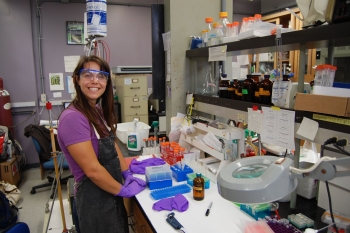
School:
Grade Level:
Teaching Position:
Supervisor:
Department:
Mentor:
Research Project Year:
Research Project Title:
Research Project Description:
In the summer of 2012, I assisted PH.D. candidate Nadine R. Martinez Rodriguez on a project to investigate the adhesive plaques of marine mussels. We were primarily working to determine whether the mussels’ adhesive proteins have antimicrobial properties. The mussel foot proteins (Mfps) were isolated using acid/urea polyacrylamide gel electrophoresis (AU-PAGE), size exclusion chromatography (SEC) and reverse phase HPLC (RP-HPLC). These methods purified the proteins down to Mfp-3 and Mfp-6 so that the antimicrobial action of each individual protein could be tested. We tested for the inhibition of growth of E.coli using radial diffusion assay. Preliminary results showed that Mfps 3 and 6 do not inhibit growth of E. coli in radial diffusion assay. However, further tests using different assays and different microbes will be conducted.
Research Project Attachments:
| Attachment | Size |
|---|---|
| 1.09 MB |
Curriculum Project Year:
Curriculum Project Title:
Curriculum Project Description:
This unit spans three to four weeks and connects the topics of density, pressure and buoyant force to the hands on activity of designing and operating under water craft. Students will explore and calculate pressure changes and buoyant force underwater through a series of short experiments. Using the knowledge gained in these labs, students will build a model of the Trieste, the first bathyscaphe to reach the bottom of the Mariana Trench. The model illustrates Archimedes’ Principle and that adding weight greater than the displaced water will cause the object to sink. They will then construct a working model of a remote operated vehicle (ROV) based on the successful “Seaperch” design from MIT. As a culminating activity students will design their own blueprint for a submersible. An extension of this engineering activity using a set of water sensors that can possibly be deployed underwater with the ROV is also explored. Using the ROV with sensors attached to collect data such as dissolved oxygen in a local marine or aquatic environment can be done as an extension or final product if equipment is available. Students can then develop a hypothesis around how these variables are connected and design an investigation of the health of the environment.
